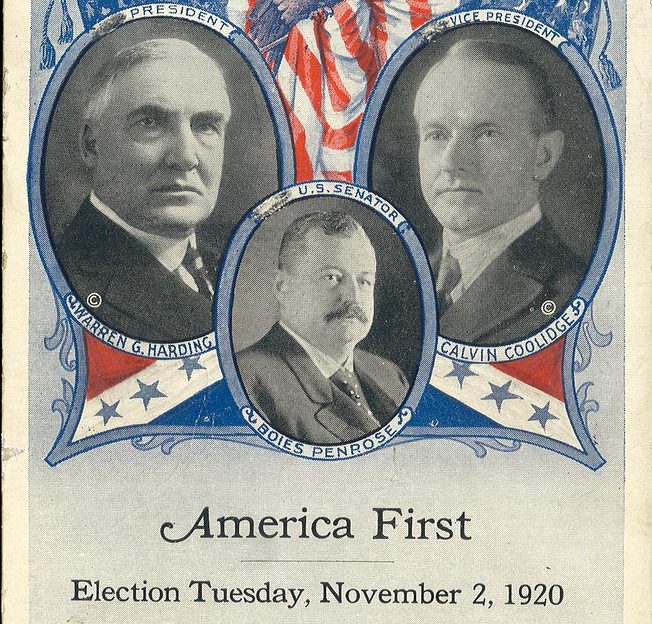The Republican Ascendancy of the 1920s is associated with a return to conservative politics with the presidential administrations of Warren G. Harding, Calvin Coolidge and Herbert Hoover.
Harding, who was elected president in the election of 1920, initiated an era of conservative government based upon policies that were rooted in constitutional limited government. Harding was a constitutional conservative who revered the American Founding. He described the Constitution as “the very base of all Americanism, the ‘Ark of the Covenant’ of American liberty, the very temple of equal rights.” Harding was a conservative nationalist who placed the interests of America first.
On Nov. 2, 1865, Warren Gamaliel Harding was born in Blooming Grove, Ohio. A conservative in a Republican Party that also had a progressive wing, Harding served in the United States Senate before winning the presidency. He supported President William Howard Taft in the Republican civil war of 1912 that split the GOP when progressives bolted to join former President Theodore Roosevelt in the Bull Moose Party.
In the 1920 presidential election, Harding campaigned on a “return to normalcy,” which translated into an abandonment of the progressive domestic and foreign policies associated with President Woodrow Wilson and a return toward constitutional limited government. He also campaigned on the slogan of “America First.”
Harding, just as with President William McKinley, ran a “front porch” campaign and thousands of people visited his home. At his home, Harding would give speeches and greet visitors. Al Jolson even wrote and performed a song, “Harding, You’re the Man for Us,” at the Harding home. Harding won the election in a landslide.
Once in office, Harding rejected the imperial presidency of Wilson and selected several notable leaders, including Andrew Mellon, Secretary of the Treasury; Herbert Hoover, Secretary of Commerce; and Charles Evans Hughes, as Secretary of State.
President Harding’s first major challenge was to pull the nation’s economy out of depression at the end of World War I. In the “forgotten depression” of 1920-1921, the nation faced 11.7% unemployment and much economic uncertainty. In the process, the national debt had escalated because of the war, tax rates were extremely high, and government spending was out of control.
The solution that Harding utilized was to restore the economy by stimulating the private sector by reducing regulations and slashing tax rates. The historian Paul Johnson, in Modern Times, wrote that the short-lived depression was the “last time a major industrial power treated a recession by classic laissez-faire methods.”
As president, Harding believed and advocated for economy in government. Harding called for reduced spending, tax reduction, and paying down the national debt. Reform was brought to the federal budget process with the Budget and Accounting Act. Although the federal government has increased dramatically in size in comparison to Harding’s time in office, he still had to say no to demands to increase spending.
Harding, along with Treasury Secretary Mellon, advocated a conservative fiscal policy. This included reducing both spending and tax rates. As a result, “federal spending was cut from $6.3 billion in 1920 to $5 billion in 1921 and $3.2 billion in 1922. Federal taxes fell from $6.6 billion in 1920 to $5.5 billion in 1921 and $4 billion in 1922,” noted Jim Powell, senior fellow with the Cato Institute. Harding also started to chisel away at the national debt.
Harding also appointed pro-business individuals to regulatory agencies, and he nominated conservatives to the Supreme Court. Some of President Harding’s Court appointments included Chief Justice William Howard Taft and Justice George Sutherland, both of whom are considered judicial conservatives. Harding also advocated a policy of civil rights and civil liberties for African Americans.
He also pushed for and achieved limiting immigration through reform, and he addressed the importance of Americanization and citizenship. In terms of foreign policy, Harding took a more nationalist approach. It is often assumed that Harding was an isolationist, but this is untrue. Harding and Secretary of State Hughes led the Washington Naval Conference, which led to disarmament in the aftermath of WWI.
Harding also placed the interests of America first in terms of trade by supporting the protective tariff. Harding believed that a tariff would benefit and protect American industry, agriculture and labor.
“I believe in the protective tariff policy and know we will be calling for its saving Americanism again,” stated President Harding.
The Fordney-McCumber tariff was passed as a result.
The Harding economic program, which was continued by President Calvin Coolidge after Harding’s death, was responsible for creating the roaring economy of the 1920s. Coolidge would continue to reduce spending and tax rates and pay down the national debt.
President Harding deserves reconsideration just as historians have given President Ulysses S. Grant, whose administration was also marked by scandal. Scandals did occur in Harding’s administration, but he was not personally connected.
Many of the policy challenges that the nation is being confronted with today could be solved by following the principles and policies of President Harding. Harding’s conservative nationalism is an example for today’s policymakers.
President Harding, just as with President Donald Trump, believed in America First and American exceptionalism. As Harding said, we are forever devoted “to safeguard America first, to stabilize America first, to prosper America first, to think of America first, to exalt America first, and to live for and revere America first.”









